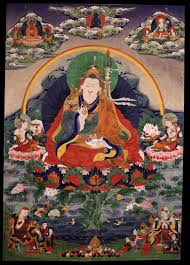The following is an excerpt from a teaching by Jetsunma Ahkon Lhamo called “Experiencing The Hook of Compassion”
Now I’m going to dive into the adult portion of our teaching, but you might have gotten something out of the children’s portion even though we’re adults, and some of us are even past 38. It looks like maybe some of us might be, and we’ve already learned some bad habits. Don’t we still move through whole passages in our lives when we just forget that we can be of benefit? We just move through and live in a way that’s relatively meaningless. We simply move through time, marking time by births, deaths, and anniversaries and summer reruns, and all kinds of things that are really pretty insignificant. We too can take hold of our lives and really become firm-, really practice accordingly.
So in the Buddhist tradition, particularly in Vajrayana, there is a kind of practice that is called devotional practice, and devotional practice has many components. But one particularly meaningful and important component is that one develops a relationship of pure devotion with one’s guru, with one’s teacher. In the Vajrayana tradition, the teacher is considered to be like the door of liberation because, even though there has been a Buddha on the earth and there has been the Buddhist teaching, even though the teaching is written in the books, even though there are many ways in which you can approach the Buddhadharma, it’s really, according to Vajrayana tradition, just about impossible to enter into the Path, into the meat of the Path, into the thick of the Path without the blessing of the teacher.
The lama is considered to be the blessing that is inherent in the Path. The lama is necessary for empowerment; the lama is necessary for transmission; the lama is necessary for teaching; the lama is necessary to make a bridge. Almost like the lama is the nurse that administers the medicine. The doctor might prescribe, the doctor might be considered the Buddha; but the lama is considered to be the nurse that actually administers the medicine while we ourselves may be too weak or too unaware to be able to hold onto the medicine or take it into our own mouths without some help. In Vajrayana tradition, from the very most preliminary practice to the very most superior practice, there is a devotional aspect to every practice that is done; and that is considered to be the vehicle or the means by which the blessing is actually transmitted.
In preliminary practice, there is actually a section of devotional yoga, guru yoga. This is something that is widespread not only in our particular tradition, but is widespread across all the traditions in Vajrayana Buddhism— the tradition of calling the lama, beseeching the lama, of invoking the lama’s blessing. Now in our particular Ngöndro, we have a beautiful passage, a beautiful song of invocation, called “Calling the Lama from Afar.” It has a very haunting melody and it’s done with one’s heart. Actually the recommendation is that one should do it until tears arise in one’s eyes. One should do that in order to soften the ego, in order to soften the mind and to make the mind like a bowl that is turned up, not turned over, hard, you know, and unable to receive any blessing; but a bowl that is turned up that doesn’t have any poison or dirt in the bottom of it, that’s kept purely; so that when the nectar comes in, it won’t be mixed with the poison or dirt. And it isn’t cracked, cracked through the distraction that we all feel when we can’t really keep our minds on any kind of devotional practice and our minds wander too much. That kind of bowl could not hold the blessing, could not hold the nectar. And, of course, if our minds are hard and filled with anger and hatred, and that anger surfaces, the bowl is turned over and the nectar simply runs off so there is no blessing to be had. We might fool ourselves thinking that we have a blessing, but in fact, no blessing has been received.
So we practice this devotional yoga; we practice it very sincerely. The benefit of this practice is immeasurable in that it softens the mind. It’s almost like planting a field of grain, you know? One has to plow the field; then one has to harrow it or disc it, turn it over. One has to soften it and rake it and work the soil so that it’s capable of receiving the seed. Otherwise if the soil were not ready, and the seed were thrown out, it would just bounce, like on a hard surface. It would not do much good. Any of you who have planted things know the truth of that. So devotional yoga is a cultivator. It’s considered to make one ready. Without devotional yoga, there is no possibility, really, of the blessing being fully received.
The devotional yoga is meant to benefit the student. It never benefits the teacher. If the teacher needs devotional yoga, the teacher is inadequate and impure; the teacher is without value. So the devotional yoga is purely for the benefit of the student. The teacher is not pleased by the devotional yoga. The teacher is pleased by the movement and the softening and the gentling and the change that occurs within the student, and that‘s because the teacher wishes to benefit the student. It isn’t because the teacher requires any kind of devotional yoga, or any kind of notice, really, at all.
Copyright © Jetsunma Ahkon Norbu Lhamo All rights reserved












Thank you, Precious Lama. How I love you!
Thank you for this very beautiful Teaching Jetsunma.
Love,
Amita Rene